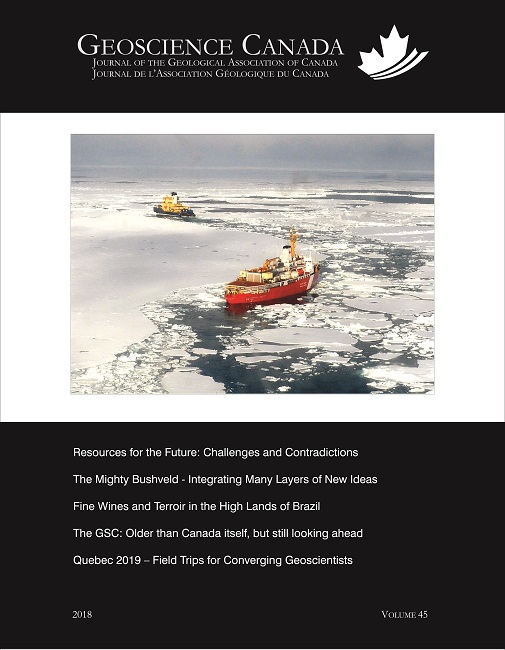Series
Publié-e 2019-01-28
Comment citer
Santos, E. A. dos, Florisbal, L. M., Loss, A., Besser, M. L., & Dortzbach, D. (2019). Geology and Wine 15. Producing Wine at Altitude: The Terroir of São Joaquim, Brazil. Geoscience Canada, 45(3-4), 137–149. https://doi.org/10.12789/geocanj.2018.45.139
Résumé
The municipality of São Joaquim, located in the Planalto Catarinense viticultural region, is the coldest wine-growing region of Brazil, and contains the highest-altitude vineyards in the country. These vineyards were established within the last 20 years, so this is a young and still-developing viticultural region. Information on the terroir of São Joaquim is needed in order to identify potential vineyard sites and to help improve the viticulture in the region. This work aims to characterize the terroir of São Joaquim, where wines are produced from grapes cultivated above 900 m of altitude, through a description and analysis of meteorological, physiographic, pedological, geological and viticultural factors. With respect to these factors, the São Joaquim region presents the following characteristics:1 It has an annual mean temperature of 13ºC, annual mean precipitation of 1680 mm/year and an annual mean solar radiation of 1832 hours/year.
2 It has altitudes between 715–1638 m and generally steep slopes, 43% of the slopes have declivities between 20–45% and show no preferred orientation.
3 It has both deep (> 150 cm) and shallow (< 100 cm) soils with clayey texture, an average pH (water) between 4.68–5.52 and an average soil organic matter (SOM) content of 6%.
4 It is underlain by two units of volcanic rocks. These are a mafic unit (50.53–55.09 wt.% SiO2) and a felsic unit (66.58–70.12 wt.% SiO2). The mafic unit tends to consist of thicker flows than the felsic unit and is characterized by generally steeper slopes.
5 There is a correlation between the geological unit and the soil types, in which thicker inceptsols are preferentially developed on the mafic volcanic rocks and thinner entisols are preferentially developed on the felsic volcanic rocks.
6 Currently, the region produces more than 27 grape varieties planted mostly on the Paulsen 1103 rootstock. The existing vineyards are mostly underlain by the mafic volcanic unit in areas of steep north-facing slopes.
This preliminary study suggests that there are correlations between the bedrock, the soils that they give rise to and the declivities of the slopes. Knowledge of these relationships should assist in the evaluation and planning of future grape and wine production.
RÉSUMÉ
La commune de São Joaquim, située dans la région viticole de Planalto Catarinense, est la région viticole la plus froide du Brésil et abrite les vignobles les plus élevés du pays. Ces vignobles ont été établis au cours des 20 dernières années; c’est donc une région viticole jeune et en développement. Des informations sur le terroir de São Joaquim sont requises pour identifier les sites viticoles potentiels et contribuer à l’amélioration de la viticulture dans la région. Ce travail vise à caractériser le terroir de São Joaquim, où les vins sont produits à partir de raisins cultivés à plus de 900 m d’altitude, au moyen d’une description et d’une analyse des facteurs météorologiques, physiographiques, pédologiques, géologiques et viticoles. En ce qui concerne ces facteurs, la région de São Joaquim présente les caractéristiques suivantes:
1 Sa température moyenne annuelle est de 13ºC, ses précipitations moyennes annuelles de1680 mm/an et son rayonnement solaire moyen annuel de 1832 heures/an.
2 Son altitude est comprise entre 715 et 1638 m et ses pentes généralement abruptes. 43% des pentes ont des déclivités comprises entre 20 et 45% et ne présentent aucune orientation préférentielle.
3 Ses sols sont profonds (> 150 cm) et peu profonds (<100 cm) de texture argileuse, avec un pH moyen (eau) compris entre 4,68 et 5,52 et une teneur moyenne en matière organique du sol (MOS) de 6%.
4 Elle repose sur deux unités de roches volcaniques. Il s’agit d’une unité mafique (50,53 à 55,09 % en poids de SiO2) et d’une unité felsique (66,58 à 70,12 % en poids de SiO2). L’unité mafique est généralement constituée de coulées plus épaisses que l’unité felsique et se caractérise par des pentes généralement plus raides.
5 Il existe une corrélation entre unité géologique et types de sol, dans lesquels des inceptsols plus épais sont préférentiellement développés sur les roches volcaniques mafiques et des entisols plus minces sont préférentiellement développés sur les roches volcaniques felsiques.
6 La région produit actuellement plus de 27 cépages principalement plantés sur le porte-greffe Paulsen 1103. Les vignobles existants reposent principalement sur l’unité volcanique mafique dans des zones de pentes abruptes exposées au nord.
Cette étude préliminaire suggère qu’il existe des corrélations entre la lithologie, les sols qu’elles engendrent et les déclivités des pentes. La connaissance de ces relations devrait faciliter l’évaluation et la planification de la production future de raisins et de vin.
